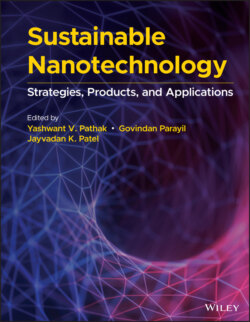Читать книгу Sustainable Nanotechnology - Группа авторов - Страница 21
1.2.2.1 Metal‐Based Drug Delivery
ОглавлениеThere are several metal‐based nanodrugs that have shown great success in treatments; however, they are known to produce large quantities of toxic and other harmful substances [40]. A way to lower the negative consequences of nanometal drugs is to modify their properties. For example, the study of biodegradable iron stents and cobalt‐chromium stents in porcine coronary arteries of juvenile pigs showed to have the potential to reduce chronic inflammation and premature recoil. Another study shows that modifying biocompatible and monodispersed iron oxide superparamagnetic nanoparticles with the combination of folic acid (FA) and polyethylene glycol (PEG) increased the affinity of nanoparticle uptake by targeted cells [41].
For antitumor therapy, two‐dimensional molybdenum disulfide (MoS₂) nanosheets have proved to be a good photothermal agent. An extensive study has shown that soybean phospholipid encapsulated MoS₂ nanosheets have shown good photothermal conversion performance and photothermal stability. In addition, soybean phospholipids can be found in nature, so the cost of obtaining it from natural resources is always lower than synthetically developing it. The reason MoS₂ nanosheets do not necessarily carry a drug to cancerous cells; however, as a photothermal agent, they can absorb near‐infrared reflectance (NIR) light and convert it into heat, which then can be transported to tumor cells. This process will bring the temperature to the critical temperature of 42 °C and result in efficient cell death. This was tested on mice with breast tumor growth by intravenously and intratumorally injecting soybean phospholipid molybdenum disulfide (SP‐MoS₂) nanosheets. Both methods showed suppression of growth of the tumor [42].
Metallic nanodrugs can also be used as antiseptics or for antimicrobial purposes. For example, hydrophilic metallic silver nanoparticle (AgNP) nanocomposites composed of a polymer matrix of N‐vinylpyrrolidone (poly [VT‐co‐VP]) have various uses in medicine especially as an ingredient in burn medicine. The study shows these metallic nanocomposites exhibiting antimicrobial activities toward Gram‐negative and Gram‐positive bacteria. Additionally, silver has shown to have more antimicrobial effect on Gram‐negative bacteria due to better linkage between the silver nanocomposites and the hydrophilic channels present in the outer membrane of Gram‐negative bacteria. In addition to antimicrobial properties, silver nanocomposites have shown to not precipitate or shrink when stored in an aqueous environment for four months. This is due to the stability of functional groups in the nanocomposites. It is proposed that these silver nanocomposites can be used for the treatment of various infectious diseases and can be quite useful after surgeries in which the major problems can be caused by exposure to bacteria [43].
